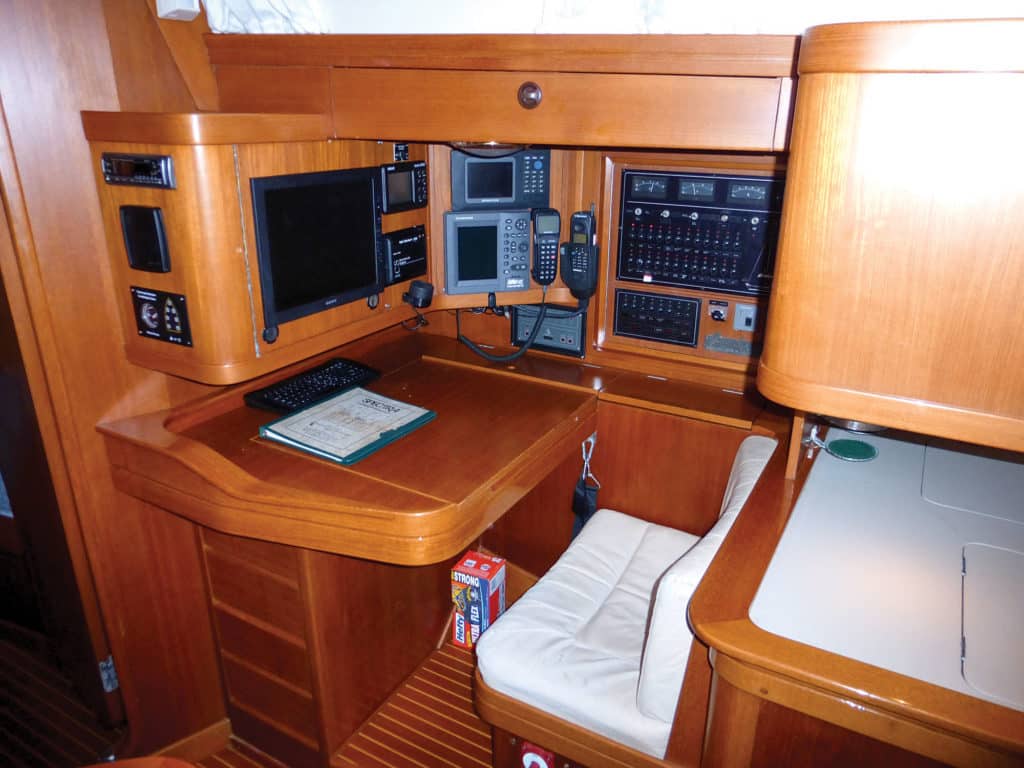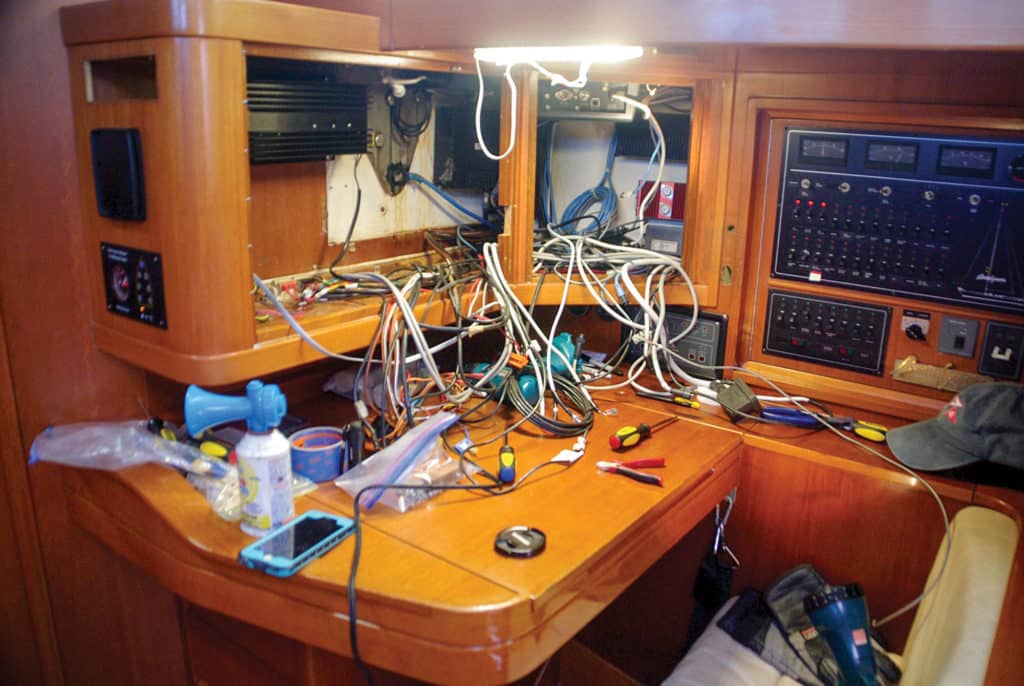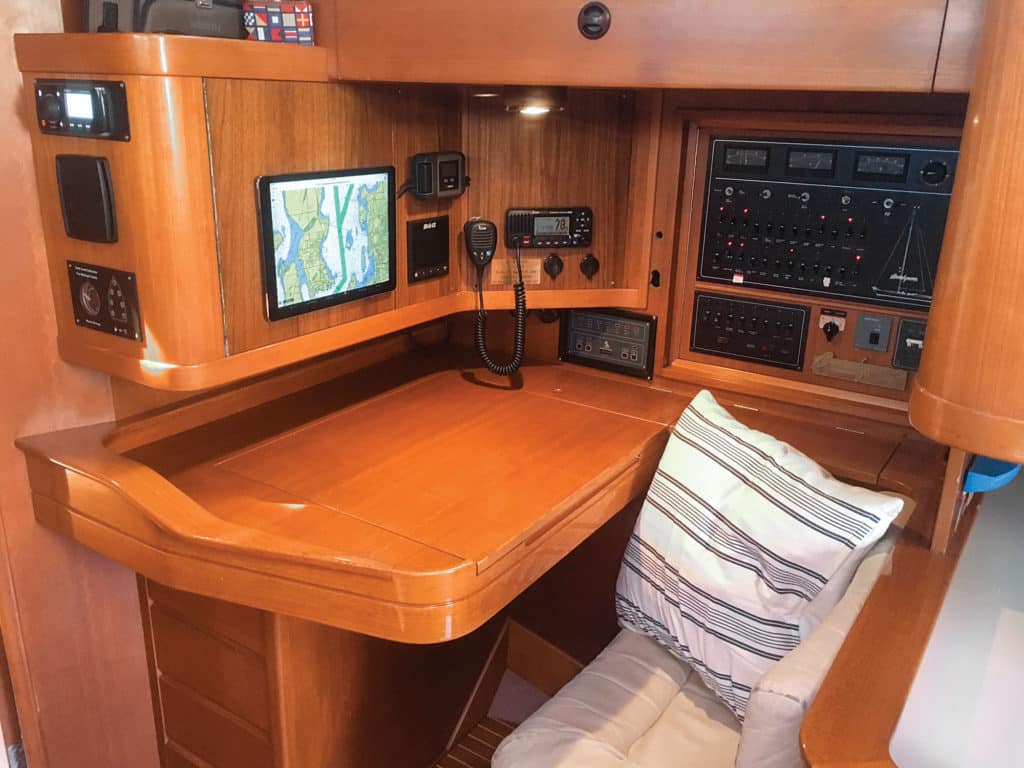
Systems
When you get right down to it, the chart table is the heart of any offshore cruising boat. It’s here that we plot our cruises and courses. Traditionalists like me still drag out paper charts, marking noon positions or poring over them, while noting coves and inlets and wondering how they look in real life. And isn’t that part of the joy of cruising? That means my chart table has to be big enough to spread out a little. On my boats, because I’m often living aboard for stretches at a time, the chart table has also had to do double duty as my office, so it has to be tidy and efficient.
When my wife and I acquired our second boat from the Massachusetts Maritime Academy’s excellent boat-donation program—director Chuck Fontaine suggested that I should enter the Newport Bermuda Race and take a bunch of Academy cadets with me as part of the crew. That sounded like a great idea, as it proved to be. (As an aside, should you ever despair of the younger generation, a few days with a crew of Mass Maritime cadets will restore your hope for the future.) Before heading out to the starting line, however, Masquerade required some serious upgrading.
At the top of the list was updating the electronics and nav station, which was a hodge-podge of outdated equipment that had been very good in its day, but that day was past. I could probably have made most of the old electronics work and used them, but I would be teaching offshore sailing and navigation aboard and wanted to familiarize crews with the latest gear. Nor did I want to spend valuable family cruising time chasing down and fixing electronic problems.The current generation of electronics provides the navigator with amazing amounts of info. Occasional racing (or “racing your living room,” as my friend Brad Read, a world-class sailor, calls it) and lots of passagemaking will be part of Masquerade’s life for the next few years. I wanted the best possible system, one that wouldn’t quickly become obsolete.
As a professional delivery skipper, I have had the opportunity to become familiar with almost all the different sailing-instrument brands available, and had been most impressed with the hoops through which I could make the B&G instrument package jump. I find them very easy to read, and if not perfectly intuitive to use, the copiously illustrated manuals were concisely written by sailors who speak the same language as me, making various functions remarkably easy to decipher.
I chose to go with the Zeus 3 plotter coupled with the H5000 processing unit and matching multifunction instruments. The plethora of available data is stunning and useful, as is the detail in the charts available for the system. I especially like the time plots that allow the navigator to track trends in the wind direction and speed, depth, course over ground, and so on. I am not talking about just the racing navigator either; cruisers will find this package equally useful. For instance, a graphic display of the bottom beats numbers alone when running along a sandy shore, and tracking the wind trends comes in very handy on any sailboat on passage.

Before I could start installing my shiny new gear, I had to remove all the old electronics and their wires and, it seemed, the wires from each previous generation of electronics that had been removed, leaving snipped-off wires in place. My friends and racing crew, Dwight Escalera and Sam Howell, helped with this miserable but satisfying chore. We estimated that we removed enough old copper to circle the globe three times. We were careful to attach messenger cords to the old wires to make it easier to run the new instrument wiring.
Installing the new system is not brain surgery, but it is complicated, and B&G specifies that the H5000 must be installed and set up by a professional. For his invaluable help and advice, I turned to my old friend Steve Gill of Custom Navigation in Westport, Connecticut. Steve has been helping me with boat electronics since the days when Loran-C was the latest thing. He is simply one of the best in the business.
One of his first recommendations was to think hard about how I wanted my nav station laid out. I thought about my priorities while staring at the new, blank teak panels I’d had made to replace the old ones that were littered with holes from the vacated gear. I wanted the area to be as clean and simple as possible, but there were a few things that I couldn’t do without: A VHF radio was a given, and for offshore work, I wanted satellite communications, mostly for downloading weather information. Steve suggested the IridiumGo. A B&G multifunction display would come in handy alongside the chart plotter.
At my wife’s insistence, we had opted for the main, 12-inch Zeus 3 display at the helm—no more squinting to read the charts and radar on deck for me. Below, I wanted an equally good repeater. Here I was able to save a boat-buck or two. (The Zeus 3 broadcasts on Wi-Fi, which allows crewmembers to get information from the plotter straight to a smartphone or tablet anywhere on the boat.) I opted to buy a refurbished 12-inch iPad and merely attach it to the bulkhead with Velcro—an inexpensive and elegant solution to the problem. Using the B&G Link app, I can view and control data, time plots, charts and the radar as if I were actually using the Zeus 3 at the helm.
Before cutting any new holes, I made a cardboard outline—or template—of all the instruments, and moved them around the new bulkhead panels, thinking about their ease of use and how much clearance was behind them. The IridiumGo was easy. It mounts on the panel, and only its wires go behind it. I would need to be able to flip up its antenna to turn it on, but I didn’t need to look at it otherwise. (The IridiumGo provides voice communication and enables you to download data such as GRIB files via an app on your cellphone, tablet or computer.) It would be mounted up high and out of the way.

I wanted the iPad front and center at eye level, not just for scanning the charts on the Zeus 3 display, but also for reading all the boat’s equipment manuals—which I would download as PDFs and store in its memory—and for writing articles such as this one. Its power cord would disappear into a hidden outlet behind it.
The B&G H5000’s multifunction graphic display, with its 5-inch screen, would fit nicely just to the right of the iPad. The Icom VHF radio was mounted unobtrusively on the right-hand panel at eye level, allowing me to easily read its screen on the rare occasions I would need to use it or operate its Digital Selective Calling functions; the microphone was mounted next to it, high enough to keep the cord off the table.
I mounted a pair of Blue Seas double 4-amp USB charging ports beneath the VHF to power the ubiquitous tablets and phones that crews find so necessary. (I also plan to install one of these double charging ports above a shelf in each cabin.) An engraved brass plaque displays the boat’s radio call sign, MMSI number, documentation number, and satellite phone number. Last, just around the corner from the instrument displays—next to the passageway to the forward cabins where it can be accessed without disturbing the navigator—I installed a Fusion MS205 stereo. I made a thin aluminum frame and painted it black to mask the larger hole from the old stereo. The Fusion plugs into the NMEA 2000 backbone on the B&G H5000, so I can control the stereo through the plotter at the helm or via the iPad below—a silly luxury, I know, but I like it and find it surprisingly convenient.
So far, the new navigation -station setup has proved easy and satisfying to use cruising, on passages, and during the latest Newport Bermuda Race, which we were winning in our cruising class until halfway through the race when the wind died. But, of course, that’s another story.
Andrew Burton has logged more than 350,000 nautical miles as a delivery skipper. He shares some of his hard-earned knowledge through his company, Adventure Sailing (burtonsailing.com), during offshore passages aboard his Baltic 47, Masquerade.








